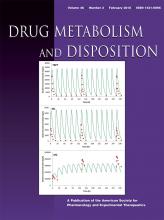Abstract
Midostaurin (PKC412) is being investigated for the treatment of acute myeloid leukemia (AML) and advanced systemic mastocytosis (advSM). It is extensively metabolized by CYP3A4 to form two major active metabolites, CGP52421 and CGP62221. In vitro and clinical drug-drug interaction (DDI) studies indicated that midostaurin and its metabolites are substrates, reversible and time-dependent inhibitors, and inducers of CYP3A4. A simultaneous pharmacokinetic model of parent and active metabolites was initially developed by incorporating data from in vitro, preclinical, and clinical pharmacokinetic studies in healthy volunteers and in patients with AML or advSM. The model reasonably predicted changes in midostaurin exposure after single-dose administration with ketoconazole (a 5.8-fold predicted versus 6.1-fold observed increase) and rifampicin (90% predicted versus 94% observed reduction) as well as changes in midazolam exposure (1.0 predicted versus 1.2 observed ratio) after daily dosing of midostaurin for 4 days. The qualified model was then applied to predict the DDI effect with other CYP3A4 inhibitors or inducers and the DDI potential with midazolam under steady-state conditions. The simulated midazolam area under the curve ratio of 0.54 and an accompanying observed 1.9-fold increase in the CYP3A4 activity of biomarker 4β-hydroxycholesterol indicated a weak-to-moderate CYP3A4 induction by midostaurin and its metabolites at steady state in patients with advSM. In conclusion, a simultaneous parent-and-active-metabolite modeling approach allowed predictions under steady-state conditions that were not possible to achieve in healthy subjects. Furthermore, endogenous biomarker data enabled evaluation of the net effect of midostaurin and its metabolites on CYP3A4 activity at steady state and increased confidence in DDI predictions.
Footnotes
- Received August 15, 2017.
- Accepted November 3, 2017.
Funding for this project, including medical editorial assistance, was provided by Novartis. Laboratories of origin for this study are the same as the affiliations.
↵
 This article has supplemental material available at dmd.aspetjournals.org.
This article has supplemental material available at dmd.aspetjournals.org.
- Copyright © 2018 by The American Society for Pharmacology and Experimental Therapeutics
DMD articles become freely available 12 months after publication, and remain freely available for 5 years.Non-open access articles that fall outside this five year window are available only to institutional subscribers and current ASPET members, or through the article purchase feature at the bottom of the page.
|







